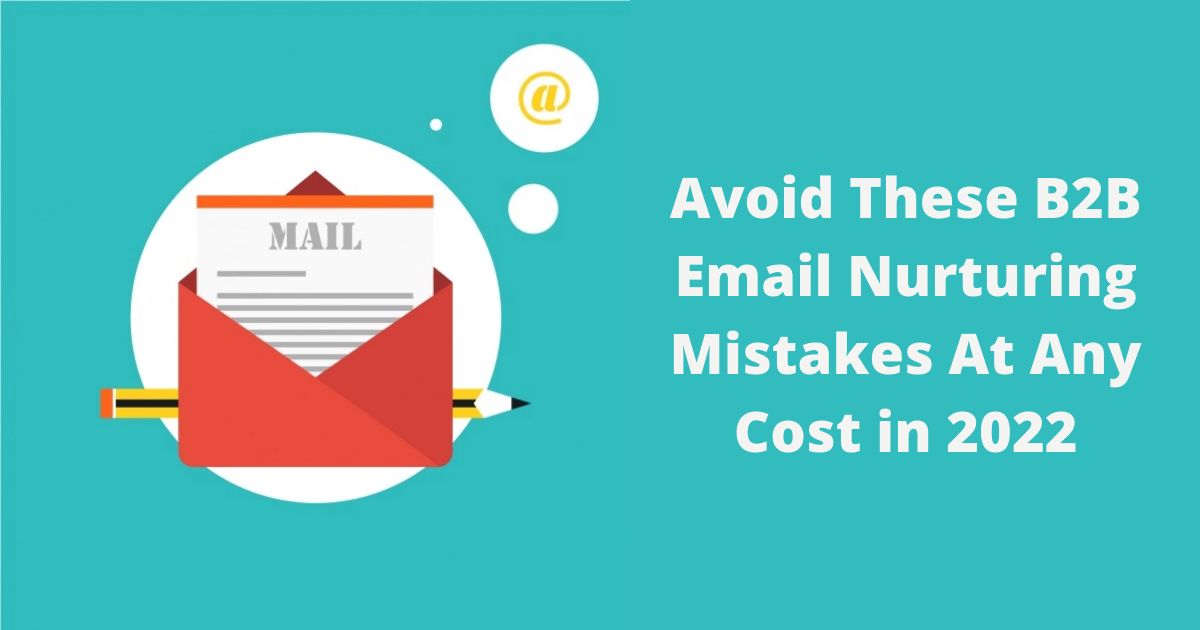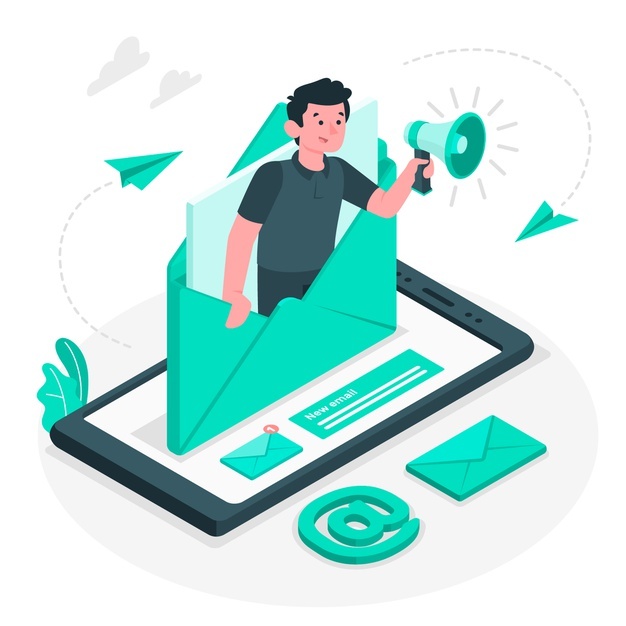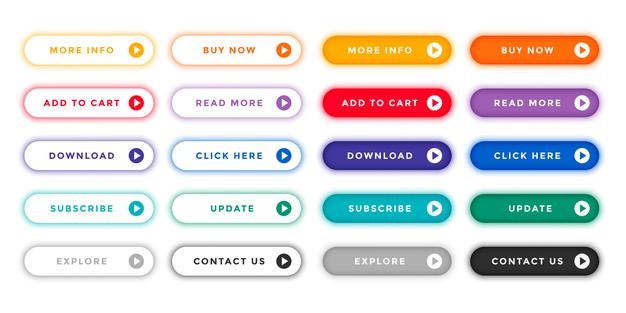Avoid These B2B Email Nurturing Mistakes At Any Cost in 2022

With an average ROI of $42 for every dollar spent and four billion global users worldwide, email stays within the top three distribution channels for both B2B and B2C marketers. And while social media platforms remain the top organic content distribution channel for user engagement, emails are 40x more effective for customer acquisition. That makes an email the essential component of marketing strategies for most business organizations, despite the growth of chat apps and mobile messengers. Here you’ll find the top 10 B2B email nurturing mistakes to avoid when planning and organizing your B2B campaigns. Seemingly evident, they are very easy to overlook, thereby burying your chances for better open rates, customer engagement, and higher conversion. Let’s shoot up a discussion on why and how can we avoid these B2B email nurturing mistakes.
B2B Email Nurturing Mistakes To Avoid At Any Cost in 2022
#1 Sending Too Many Marketing Emails

This is a tricky one. Knowing how many emails to send depends on a few factors:
- Who you’re sending it to (your buyer personas)
- Their preferences/optimal send times/days
- What you’re sending
- What they’ve already received from you and when
Daily sends to the same list of contacts every single day would be insane and we’ve never seen anyone do this because, well, it’s insane.
Whereas sending daily emails to separate audiences, would be considered acceptable– and probably likely as your database grows.
To run an effective email campaign, you could require a weekly email or a bit less time in between. It really depends on the content and its relevance to the audience. For what it’s worth, the best day, with the highest email open rates, is Tuesday with 17.6% for all industries.
The important thing to know here is that if you send too many emails without someone engaging (opening or clicking) then the HubSpot software will mark them as unengaged.
You don’t want spray and pray email marketing. It should be strategic and answer customer pain points and be relevant to their industry/persona/department/job title.
Once you’re sending emails regularly, you should track engagement and calibrate accordingly. If your engagement is good, then you should optimize based on data and stay the course. If your open and click rates are low, you may want to back off to a less frequent sending schedule.
One thing to keep in mind is that marketing emails are different from weekly subscription emails (blog feeds, newsletters, weekly tips). The frequency for subscription emails is often chosen by the recipient, so in this case, daily or weekly is ok.
#2 Sending Poorly Designed or Poorly Written Emails
Now that you have a clean, responsibly-sourced (you’d think we were talking about salmon) contact list, you’ll need to send an email that was designed and written to represent your brand properly and communicate your message clearly.
Things to Avoid in Email Marketing
- Extremely vague subject lines
- Email Subject lines that exceed 5-6 words
- No personalization in the email greeting
- Overwhelming or too many graphics
- More than three typefaces
- Email design exceeds 500-650 pixels wide
- More than one call-to-action (CTA)
- Not opening quickly with your main message
- Email that exceeds more than two short paragraphs
- Excessive use of exclamation points (calm down)
- Content with typos (use the Grammarly app!)
- Using a No-Reply sender’s email address
- Not considering mobile-friendly design
There are cases where longer emails (for example – company newsletters) make sense. Marketing emails within a campaign should be kept to 2 paragraphs.
#3 Incorrect Personalization
Marketers know the power of personalization in email, calling a customer by name, to say the least, when sending messages. But today, users are smart enough to understand that personalization in emails is all about proper tags a marketer places into an automation tool. That is why calling subscribers by names in emails may not have the same positive effect as before.
It’s a mistake to forget to check tags or names website visitors use when subscribing to your newsletters. Typos happen, or they can write nonsense on purpose, something like “Don’t write me!” to catch you out.
Using such names in the hope of customer loyalty, you can get a polar opposite result. To avoid that, please check all fields twice before sending an email. Also, you might want to do A/B testing of your email marketing campaign to see if personalization by name influences conversion.
Besides mistakes in the receiver’s name, please make sure to avoid:
- Spelling and grammar mistakes in the email’s body
- Broken links
- Errors in fields like Sender Name and Reply-to Email Address
#4 Subject Line and Body Content Mismatch
Everyone knows that email subject lines matter. They engage and motivate users to open an email for further information. The problem is that some marketers misunderstand the role of subject lines, using them as clickbait in chase of high open rates.
In cases like those, a user does open an email but doesn’t see any related content in the email’s body. They consider you a manipulator, mark your emails as spam, and unsubscribe from you. Plus, your brand reputation will suffer: Users won’t trust it anymore.
It’s okay to encourage subscribers to open your marketing emails. Personalization, trigger words, questions, and smileys are among writing tricks specialists use in email subject lines to hook recipients, fuel their curiosity, and encourage them to click.
Try to do your best to avoid subject lines and body content mismatch: Write compelling subject lines that will be relevant to the email content you share.
#5 Adding Too Many CTAs

The perennial question of most email marketers is – How many CTAs in an email should we use? Is it okay to use a few, and how many email CTAs are too many for one message?
A simple and straight answer would be – It’s okay only to use a few CTAs in your email if they all lead to one page and action.
Some specialists continue overwhelming their newsletters with several CTAs of different goals: visit a website, leave feedback, order, subscribe, etc. It makes users get lost and misunderstand what they should do next. Plus, it becomes challenging to measure such campaigns as marketers have to analyze several metrics with different data.
Here are a few pointers you would like to remember:
- The more options you give, the more likely you’ll lose customer attention: Make them understand what exactly you want them to do and follow the best practices of email CTAs designed for that.
- CTA buttons perform better than links because they are more visually appealing and inviting to click: With the help of HTML, you can make it stand out. Use more extensive text than in the email body (but don’t make it too massive) and make it touch-friendly for mobile users.
- Place it right: The upper-left corner is the best option for emails that users read on mobiles. The right-hand side of the email text is perfect for taking advantage of the natural direction of reading flow. And, CTAs placed above the fold enhance your chances to hook readers who don’t scroll to the bottom of your email.
#6 Missing Segmentation
Segmentation is a must in email marketing. It influences open rates (15% higher on average), clicks, and conversions. And given that the ultimate goal of digital marketing is to generate revenue, it’s no surprise to see emails a part of the sales funnel:
There were case studies when customer segmentation helped retailers increase revenue by 140% and more. Plus, you can get an improved unsubscribe rate by sending relevant emails to different customer groups.
So, segment your email list based on subscribers’ data such as age, gender, interests, location, and more. Their purchasing habits, level of engagement, and device they use to open and read your emails are also good segmentation strategies to consider.
If you don’t have any information except their emails, consider a behavioral segmentation with the help of RFM analysis.
Once ready, work with each segment of your audience separately. You may want to send emails asking for feedback to loyal customers, special offers to promising ones, and so on. The more relevant your email content will be to each segment, the better.
#7 Working With Outdated Email Lists
With all the requirements providers set for the email list quality, including the limits on acceptable returns and complaints, it’s critical to keep it relevant and updated. Otherwise, dozens of long-abandoned mailboxes appear there over time, hurting your deliverability.
As a result, you’ll get an increased spam rate, exceed the provider’s limits, and your newsletters will get blocked.
To deal with that, get the most out of automation:
- Try using email validation services to analyze your email list and delete suspicious and non-working email addresses from it.
- Another trick is to grow your email list gradually and clean it regularly. It will allow you to avoid suspicious activity all email providers don’t like.
#8 No System In Sending Newsletters
A big mistake would be to email subscribers whenever you want or have time to craft exciting content with video editors, infographic makers, or text-editing apps. When it comes to their inboxes, people love order and a kind of predictability; and that is why they choose the frequency of emails they want to get from you.
By the way, giving them no chance to do that is one more email marketing mistake to mention in this list.
So, do your best to systematize your newsletter. Make an email marketing plan for a few months ahead and decide on days and times for sending your emails to subscribers.
While Tuesdays and Thursdays’ middles of the day are the two most popular days to send emails, the ideal variant would be to test a few options. Analyze your audience’s activity and build your email marketing strategy based on that.
#9 Not Having Dedicated Landing Pages
You’re not sending emails for emails’ sake – your email is supposed to ask your receiver to watch something/do something/go somewhere/read something.
So it’s very important to have dedicated landing pages that are contextually relevant to the content in your email.
For example, if you’d like a recipient to register for a webinar, you will need a dedicated webinar page set up with all of the relevant information, including a registration form.
Or, if you’re asking someone to watch a video, send them to your optimized YouTube page or a landing page with clear next steps.
The beauty of having landing pages or social media pages is that we can track your recipients’ behavior and see if they converted.
#10 Not Allowing Feedback

Among the most common B2B Email Nurturing Mistakes is sending emails with “do not reply” messages. As a rule, such emails come from “no-reply” or “admin” addresses or from those no one ever checks.
If you’re still doing so, please stop. No user wants to have dealings with a brand that doesn’t give them an opportunity for feedback. It’s a signal you don’t want to hear from customers, which is not that great when building brand loyalty and reputation.
Besides, it hurts your delivery and conversion rates, leading to increased spam rates and cuts off communication.
Send your newsletters from an email address that lets users write back. If you have no resources to manage their feedback, try sharing other communication channels in emails, using electronic signatures with alternative contacts, or adding a reply button to guide users to a dedicated landing page dealing with queries.
Give people an opportunity to talk to your brand and get answers to their questions. Thus you’ll enhance the chance to make them your clients.
Wrapping Up
Email marketing remains super effective for customer acquisition, and that’s why many brands consider it an essential part of their sales funnel.
Well, no one’s really perfect in this world, and even the most experienced marketers aren’t immune from mistakes. This article’s ten most common B2B Email Nurturing Mistakes are here to freshen your memory of the fundamentals, which are so easy to miss or forget when chasing trends and struggling for customer attention
